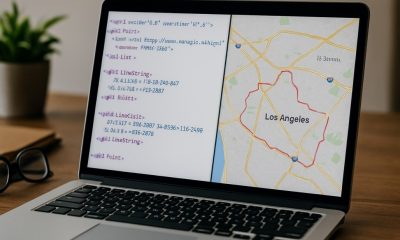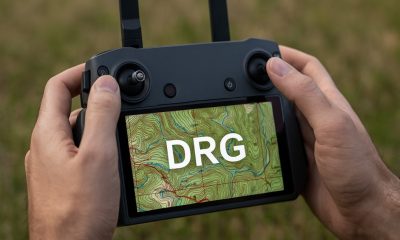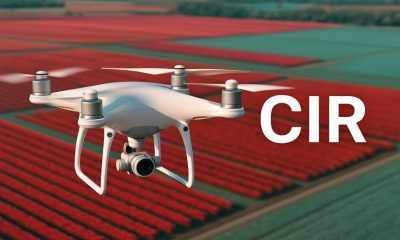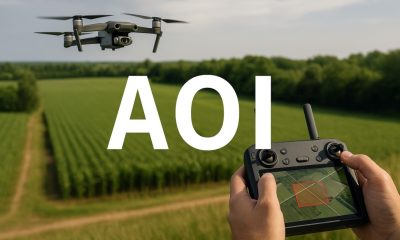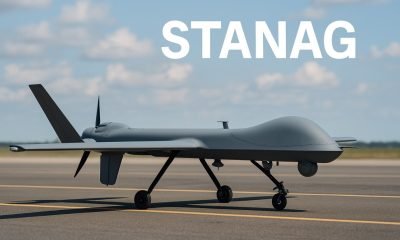U.S. Drone Regulations
Drone Regulations – Upcoming Changes in America (2025)
Published
11 months agoon
Table Of Contents
![Drone Regulations - Upcoming Changes in America ([year])](https://www.flyeye.io/wp-content/uploads/2024/07/US-Drone-Regulation-Changes.jpg)
Upcoming Changes to Drone Regulations in the United States
The United States is set to implement several changes to its drone regulations in 2024, primarily driven by the FAA Reauthorization Act of 2024. These updates aim to expand drone operations, enhance safety protocols, and support the growing use of drones in various sectors.
Impact of the FAA Reauthorization Act of 2024 on BVLOS Operations
The FAA Reauthorization Act of 2024 is set to significantly impact Beyond Visual Line-of-Sight (BVLOS) operations, marking a transformative step in the regulatory landscape for drone usage in the United States. Here are the key impacts:
1. Establishment of Performance Standards
The act mandates the FAA to develop performance-based standards for BVLOS operations. This shift will allow drones to operate beyond the direct visual line of sight of the operator, significantly expanding the range and potential applications of drone technology. These performance standards will set the criteria for safe and reliable BVLOS operations, ensuring that drones can detect and avoid other air traffic, obstacles, and potential hazards independently.
2. Commercial Applications and Opportunities
By facilitating BVLOS operations, the legislation opens up numerous commercial opportunities:
- Package Delivery: Companies will be able to use drones for delivering goods over longer distances without the need for continuous visual monitoring by the operator.
- Infrastructure Inspections: Drones can be deployed to inspect critical infrastructure such as power lines, pipelines, and bridges more efficiently and safely. This is particularly beneficial in remote or hazardous locations.
- Agricultural Monitoring: BVLOS capabilities will enhance precision agriculture practices, allowing for extensive monitoring of large farm areas, which can improve crop management and yield predictions.
3. Competitive Advantage
The streamlined approval process for BVLOS operations is expected to provide a competitive edge to American drone manufacturers and service providers. By establishing clear and achievable standards for BVLOS, U.S. companies can better compete globally, particularly against nations like China, which have been advancing rapidly in drone technology.
4. Innovation and Economic Growth
The expansion of BVLOS operations is likely to spur innovation within the drone industry. Companies will invest more in developing advanced drone technologies, including improved sensors, autonomous navigation systems, and enhanced communication protocols. This growth will not only drive technological advancements but also contribute to economic growth by creating new jobs and business opportunities within the drone ecosystem.
5. Regulatory Framework and Compliance
The FAA’s establishment of these standards will involve a detailed regulatory framework that drone operators must adhere to. This includes obtaining the necessary certifications and approvals, which will ensure that only drones meeting stringent safety criteria are allowed to operate BVLOS. Such a framework will help mitigate risks associated with BVLOS operations and promote public trust in the safety of drone technology.
6. Timeline and Implementation
The act requires the FAA to issue a notice of proposed rulemaking within four months and to finalize the rule within 16 months. This timeline ensures that the industry will soon have clear guidelines and standards to follow, accelerating the deployment of BVLOS operations across various sectors.
Continuation of the BEYOND Program
The BEYOND program, which collaborates with private industry to collect data and develop drone standards, will continue for at least another five years. This program helps inform policies around the safe deployment and operation of drones.
Impact of the FAA Reauthorization Act of 2024 on Infrastructure Inspections
The FAA Reauthorization Act of 2024 is poised to significantly enhance the use of drones for infrastructure inspections, providing substantial benefits in terms of safety, efficiency, and economic impact.
1. Grant Program for Infrastructure Inspections
Funding Allocation: The act allocates $12 million annually over the next four years to support governmental entities in using drones for infrastructure inspections. This funding is designed to encourage the adoption of drone technology in inspecting, maintaining, and repairing critical infrastructure such as bridges, roads, railways, and utilities.
Usage of Funds: Government agencies can use these grants to:
- Purchase or lease drones equipped with advanced inspection capabilities.
- Hire drone service providers to conduct inspections.
- Train personnel in drone operation and data analysis.
- Develop and implement drone-based inspection protocols and systems.
2. Enhanced Safety
Worker Safety: Drones can access hard-to-reach or hazardous areas, reducing the need for human inspectors to work in dangerous conditions. For example, drones can inspect the underside of bridges, the tops of tall structures, or areas affected by natural disasters without exposing workers to potential harm.
Detailed Inspections: Equipped with high-resolution cameras, thermal imaging, LiDAR, and other sensors, drones can perform detailed inspections that might be difficult or impossible for human inspectors. This ensures thorough assessments of infrastructure conditions, leading to early detection of issues such as cracks, corrosion, or structural weaknesses.
3. Operational Efficiency
Speed and Coverage: Drones can cover large areas quickly, making inspections faster and more efficient compared to traditional methods. This is particularly beneficial for extensive infrastructure networks such as power lines, pipelines, and railways.
Cost Savings: Using drones for inspections can significantly reduce costs associated with scaffolding, lifts, and other equipment required for manual inspections. Additionally, drones minimize the need for traffic closures or other disruptions, further reducing operational expenses.
Real-Time Data Collection: Drones can provide real-time data and imagery, enabling immediate analysis and decision-making. This rapid feedback loop allows for timely maintenance and repairs, preventing minor issues from escalating into major problems.
4. Data Management and Integration
Advanced Analytics: Drones equipped with sophisticated sensors can collect vast amounts of data. This data can be analyzed using advanced software to identify patterns, predict maintenance needs, and optimize resource allocation.
Integration with Existing Systems: The data collected by drones can be integrated into existing infrastructure management systems, creating a comprehensive view of infrastructure health. This integration facilitates better planning and coordination of maintenance activities.
5. Economic Impact
Job Creation: The adoption of drone technology for infrastructure inspections will create new job opportunities in drone operation, data analysis, and maintenance planning. Training programs supported by the act’s funding will help develop a skilled workforce to meet this demand.
Market Growth: The increased use of drones for infrastructure inspections will drive demand for advanced drone technologies and services, stimulating growth in the drone industry. This growth will have a ripple effect, benefiting related sectors such as manufacturing, software development, and training services.
Regulatory Requirements:
- General Flight Rules:
- Drones must fly at or below 400 feet in Class G airspace. For operations in controlled airspace (Class B, C, D, and E), authorization through LAANC or DroneZone is required.
- Operators must maintain a visual line of sight with their drones or use a visual observer. Night flying requires anti-collision lighting.
- Certification and Registration:
- All drones weighing between 0.55 pounds and 55 pounds must be registered with the FAA. Registration costs $5 and is valid for three years.
- Commercial drone pilots must obtain a Remote Pilot Certificate under Part 107, which includes passing an aeronautical knowledge exam and meeting age and language proficiency requirements.
- Commercial Operations:
- Commercial drone operations are subject to additional rules, including flying at or below 100 mph, yielding to manned aircraft, and not operating from moving vehicles unless in sparsely populated areas.
Impact of FAA Reauthorization Act of 2024 on Drone Users
The FAA Reauthorization Act of 2024 brings substantial changes that will impact both recreational and commercial drone users. Here’s how:
1. Expansion of BVLOS Operations
Commercial Opportunities:
- Enhanced Capabilities: The establishment of performance-based standards for BVLOS operations will allow commercial drone users to undertake more complex and longer-range missions. This opens up opportunities for applications like package delivery, infrastructure inspections, and agricultural monitoring.
- Regulatory Clarity: With clear guidelines, drone manufacturers and operators can develop and utilize BVLOS technologies more effectively, fostering innovation and growth in the industry.
Operational Adjustments:
- Training and Certification: Drone operators will need to obtain new certifications specific to BVLOS operations. This includes meeting performance and safety standards, which may require additional training and investment in more advanced drone technologies.
2. Infrastructure Inspections
Government and Commercial Use:
- Grant Opportunities: Governmental entities and businesses involved in infrastructure maintenance can apply for grants to integrate drone technology into their inspection processes. This financial support can help offset the costs of purchasing drones and training personnel.
Efficiency and Safety:
- Improved Safety: Drones can safely access hazardous or hard-to-reach areas, reducing the risk to human inspectors. This enhances the overall safety of inspection operations.
- Operational Efficiency: Drones can perform inspections more quickly and cover larger areas than traditional methods, resulting in time and cost savings.
3. Educational and Training Programs
Enhanced Learning Opportunities:
- Grant Programs: Educational institutions will have access to funds for developing drone training programs. This will provide more comprehensive education and training for future drone operators, ensuring a well-prepared workforce.
- Skill Development: Current and aspiring drone users will benefit from improved training resources, making it easier to acquire the necessary skills and certifications.
4. Regulatory Compliance and Safety
Operational Changes:
- Strict Compliance: Users will need to adhere to new regulations, including registering their drones, obtaining the necessary certifications, and following updated safety guidelines. This may involve additional administrative tasks but will ultimately enhance the safety and reliability of drone operations.
- Community Impact: With a focus on safe integration into the national airspace, drone users must ensure their operations do not interfere with manned aircraft or pose risks to people on the ground. This promotes responsible drone usage and public trust.
5. Economic and Competitive Advantages
Market Growth:
- Business Expansion: The clear regulatory framework and support for BVLOS operations will enable businesses to expand their services and explore new markets, driving economic growth in the drone sector.
- Competitive Edge: U.S. drone companies will be better positioned to compete globally, thanks to streamlined approval processes and performance standards that support advanced drone operations.
Conclusion
The FAA Reauthorization Act of 2024 will have a wide-ranging impact on drone users, providing new opportunities for commercial applications, improving safety and efficiency in infrastructure inspections, and enhancing educational and training programs. By fostering innovation and ensuring regulatory compliance, these changes will help integrate drones more effectively into various sectors, benefiting both the industry and the broader community.
For examples of acronyms used in this article visit our page.


